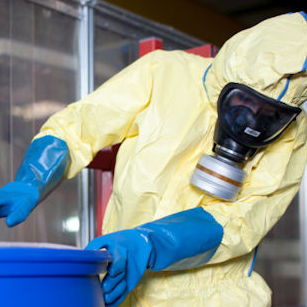Materials
Nearly every production job involves the use of hazardous materials including chemicals for cleaning, stripping, or degreasing parts and equipment. Maintenance workers who enter enclosed or confined spaces are also exposed to toxic substances.
Solvents: Solvents are used to dissolve various materials. Those commonly used include:
- trichloroethylene
- acetone
- percholoroethylene
- toluene
- methylene chloride
- glycol ether
Exposure occurs by inhalation, ingestion, and absorption primarily through skin contact. Skin exposure may result in dermatitis or skin rash, edema or swelling, and blistering. Solvents can dissolve the body's natural protective barrier of fats and oils leaving the skin unprotected against further irritation.
Inhaling or ingesting solvents may affect the central nervous system, acting as depressants and anesthetics causing headaches, nausea, drowsiness, dizziness, complaints of irritation, abnormal behavior, general ill-feeling, and even unconsciousness.
Acids and alkalis: Acids and alkalis may cause serious burns if they are splashed into the eyes or onto the skin. If vapors or mists are inhaled, they may result in a burning of the linings of the nose, mouth, throat, and lungs.
Metals: Employees are exposed to metals primarily by skin contact and by inhalation of metal dusts and fumes. Exposure may cause headaches, general ill-feeling, anemia, central nervous system and kidney damage, and reproductive problems, as well as cancer.
Gases: Gases are used in many operations and may combine with other substances to produce toxic gases such as phosgene, ozone, and carbon monoxide. Common hazardous gases are hydrogen sulfide and methane. Potential exposure to gases occurs through inhalation. Exposure may produce eye damage, headaches, shivering, tiredness, nausea, and possible kidney and liver damage.
Solids: Solids like metal, wood, plastics. Raw materials used to manufacture products are usually bought in large quantities, and can cause injuries or fatalities in many ways.
Plastics and Resins: Inhalation or skin contact may occur when curing resins; cutting, heating, or stripping wires; or cutting, grinding, or sawing a hardened product. Exposure to these substances may result in skin rash and upper respiratory irritation.
Polychlorinated Biphenyls (PCBs): PCBs are used as insulators in some electrical equipment and present a potential hazard to workers. Exposures to PCBs may cause skin disorders, digestive problems, headaches, upper respiratory irritations, reproductive problems, and cancer.
Fiberglass and Asbestos: Fiberglass and asbestos are also used as fillers in epoxy resins and other plastics, in wire coatings or electrical insulation, and in printed circuit boards. Uncontrolled exposures may produce skin and upper respiratory irritations and, in the case of asbestos, cancer.
Knowledge Check Choose the best answer for the question.
1-5. Which type of materials are used to dissolve other material, but can be a hazard through exposure primarily through skin contact?
You forgot to answer the question!

